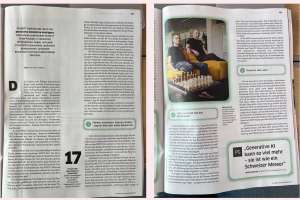FROM PROF. DR. PETER GENTSCH
AI in Germany – what is to be done concretely?
Waiting for politics and legislation is certainly not a good advice. Curiosity and courage to use AI is the first important step. As the successful corporate examples show – we simply have to do it! Of course there is no patent remedy or the 10 golden rules of AI. However, in the following, concrete impulses, approaches and initiatives are to be pointed out:
BUSINESS POTENTIAL:
There are various approaches to derive the necessary business imagination and to systematically identify the respective business potential for the company:
-
Empowering AI Leadership – Toolkit for Boards of Directors: is a toolkit developed by the WEF, which describes in 12 modules the definition and implementation of AI measures for decision makers.
-
AI Healthcheck and Compliance Framework: helps managers to introduce AI into the organization, especially with regard to ethics, data protection and compliance aspects.
-
AI Maturity Model: shows how different companies and industries develop and use AI at different stages of maturity. It is particularly interesting to look beyond the horizon: what are other industries doing that may already be developed further.
-
AI Solution Matrix: lists AI use cases in a matrix, evaluated according to implementation effort and business impact. It is advisable to first get an overview of the solution space, in order to then prioritize the use cases with low implementation effort and high business impact.
-
AI Thinking: applies the principles of a market- and customer-centric perspective of Design Thinking to AI.
DATA:
One of the biggest challenges besides the lack of market imagination is the acquisition of data relevant to AI. Here, too, there are different approaches:
Data strategy: Which data is currently missing, how could this data gap be closed? How could a “Tesla sensor system” for my business look like? Which devices, contact points and processes can be used to systematically collect data in the future.
Data alliances: With which companies and organizations can I share data? Ströer and Otto are a good example how two companies share market data. This alliance has created the largest German data pool for login, e-commerce and behavioral data.
Open Data: There is a lot of publicly available data. Which data can be used for my business?
Synthetic Data: Synthetic data can be generated using AI. This allows relevant training and test data to be generated in compliance with data protection regulations.
Transfer Learning: is an AI approach that tries to transfer AI models between different domains. Thus, even a domain in which only small amounts of data are available (small data) can learn from a domain in which AI models have already been successfully developed.
AI RESOURCES:
One of the most frequently mentioned obstacles in Germany is the lack of appropriate skills and systems. In recent years, AI has been democratized. Thus, today powerful AI frameworks are available as open source.
Open AI: TensorFlow, one of the most powerful AI frameworks was developed as Open Source by Google. Open AI, a non-profit organization supported by Elon Musk and Peter Thiel, among others, offers various algorithms and tools as open source.
Partnerships with institutes: HTW Aalen, TUM, Fraunhofer IAIS are mentioned here as examples of organizations that support companies with AI know-how and resources.
Co-Innovation is a model to develop AI processes and products in partnership.
Enable employees: Not to forget your own employees. Experience shows that in many departments, analysis and IT departments, there are great interests and motivations to learn and apply AI. This job enrichment can be achieved through various AI trainings (online and offline). Further training programs for employees are also offered by the institutes mentioned above.
GUIDELINES AND PRINCIPLES:
There are various guidelines and principles that provide companies with an orientation framework for the development and introduction of AI.
OECD Principles on AI: The OECD members and six partner countries have agreed on initial principles for dealing with AI. The Principles comprise five value-based principles for the responsible use of trustworthy forms of artificial intelligence. They are intended to support organisations in designing and using AI systems in such a way that the well-being of human beings is always paramount.
Ethical guidelines for EU AIs: An independent group of experts on AIs appointed by the EU Commission has defined ethical guidelines for the development of trustworthy AIs. The 33 requirements support a people-centred approach to AI and recognise that AI is one of the most transformative technologies for innovation and productivity.
AI4Europe: 28 countries have established an AI consortium to support scientists, entrepreneurs, SMEs and industries in Europe. In addition to technical advice, financing is also offered.
AI Frankfurt Rhein-Main e.V.: is an example of an initiative that is initially regional in scope. This “Marketplace for AI” has developed an AI Solution Map, which provides an overview of AI activities in the Rhine-Main area. This makes it clear who is involved in which AI application, in what way and to what extent.
INVESTORS
Business Intelligence Group and Asgard, which invest in AI projects and start-ups as German investors, should be mentioned as examples.
CONCLUSION AND OUTLOOK
The arguments “AI made in Germany” or European ethics and data protection regulations will not stand up to the global economic test of strength. A sluggish government, regulatory protectionism and regional ethics committees will certainly not help the solution. Our argument must be the clear value proposition of “value creation through AI”. We have excellent AI scientists and technologies in the country. We must find incentives and models for investors and entrepreneurs to transform our world-leading know-how into business processes and models. This includes close cooperation and data alliances within and between sectors as well as between industry and research. This redefinition of the share economy can be the European key to AI technology and innovation leadership!



